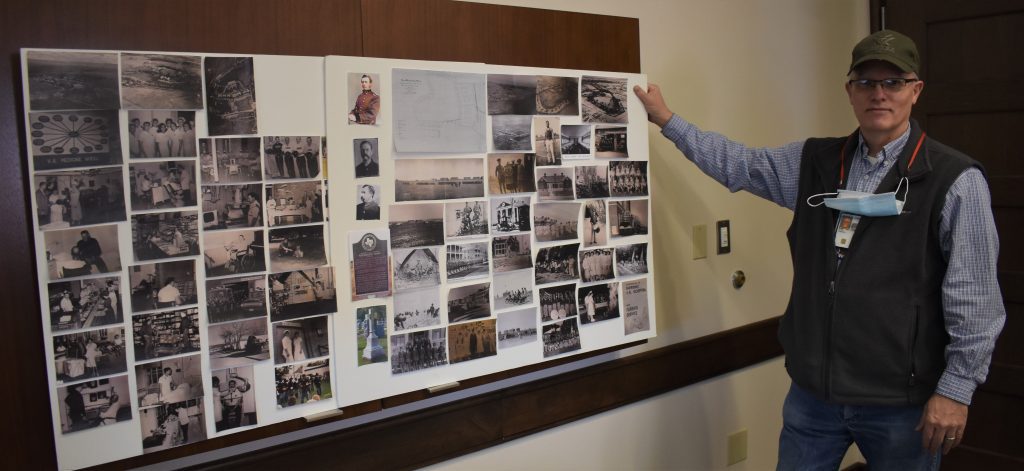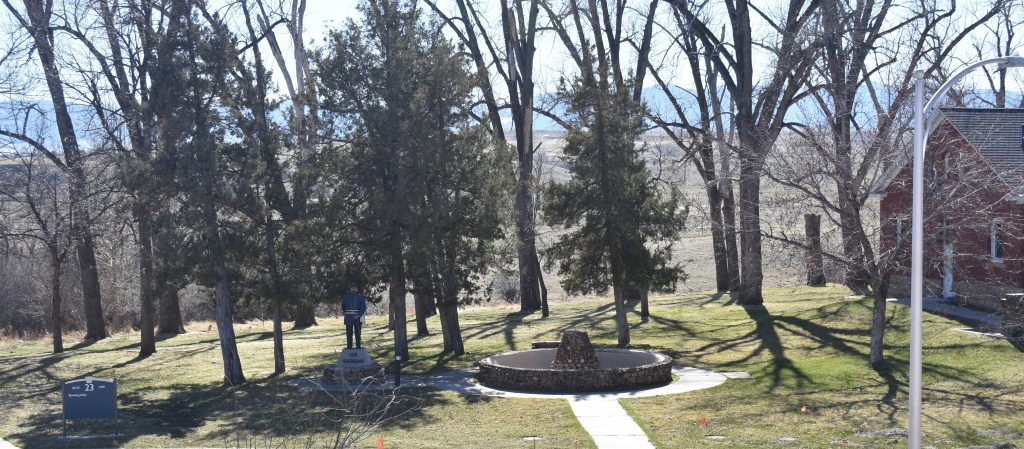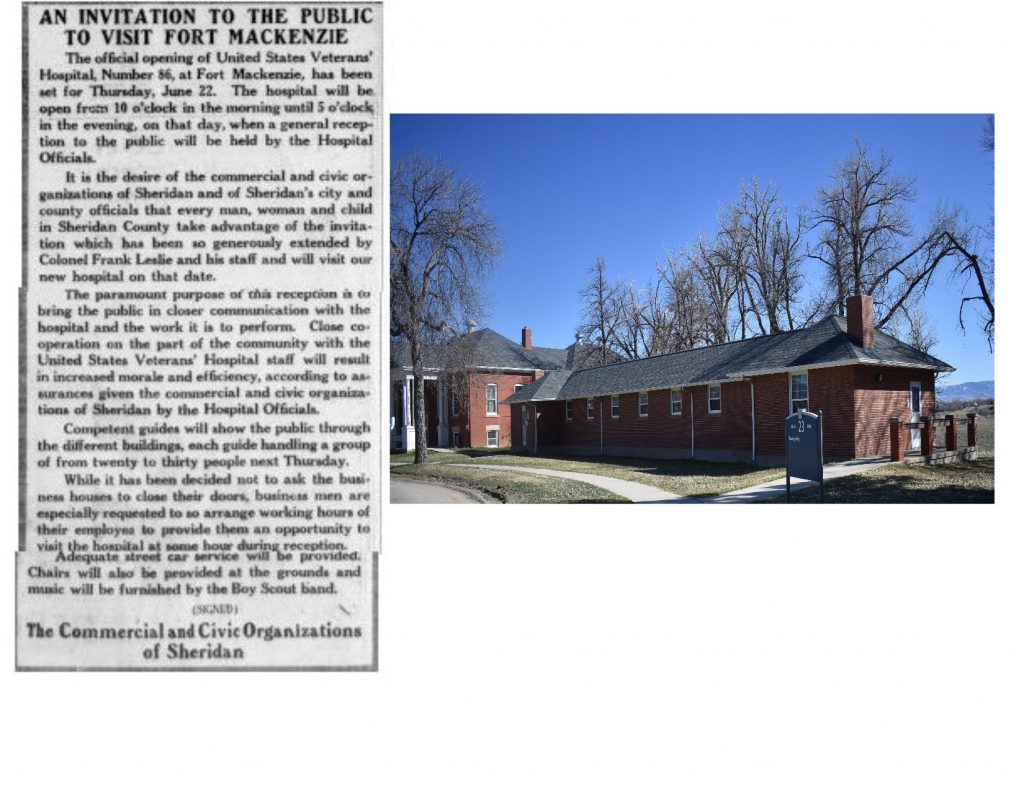News
From Fort to Hospital, Sheridan’s VA is 100 Years Old this Year

There will be a celebration on September 10 honoring the Sheridan Veteran’s Administration hospital’s 100 years, 1922-2022. The fort itself is older, having been built in 1899. A story on the history of Fort Mackenzie was featured on Sheridan Media on November 13, 2021. At first the fort was log buildings, corrals and a coal storage building. Later, the fort was constructed of brick, and rivaling F.E. Warren, originally Fort D.A. Russell, in Cheyenne and Fort Yellowstone near Mammoth Hot Springs in Yellowstone.
In the early 1900s, congress began closing down the smaller forts, consolidating into larger forts in large urban areas, such as Cheyenne.
Sheridan was not one of the large urban areas. The government left only a few soldiers to maintain the buildings and grounds. The fort buildings were well built and practically brand new. Several attempts were made to repurposed, including the idea of a military school, but none were really successful until after the first World War, when it became a Veteran’s Hospital.

In The Laramie Boomerang, May 1921. Maj. J. B. Anderson to Be Placed in Charge of New State Hospital Sheridan, Wyo., May 7—Major John B. Anderson, of the medical department of the United States army, who will be in charge of the reconstruction of Fort Mackenzie, arrived in the city yesterday from Seattle. However, Major Anderson brings no information as to when actual operations will begin. His orders are to report at Sheridan and further orders must come from Washington before anything is done. It is reasonable to infer, however, that the beginning of work will be delayed but a short time. The city and county are both engaged in forwarding the work on the roads which was promised, and the remodeling of the fort Into a hospital will no doubt begin at an early
The transition was not easy. Thomas Hatch, Sheridan VA Engineer Tech and historian, talked about the making the fort into a state of the art VA hospital.

Hatch has been working on the history of the hospital even before the 100 year celebration, slated for September 10, 2022. “They asked me to give a speech on the flagpole, one of the first permanent structures here at the fort.” When one looks at the fort flag poles they would notice they all look the same, and look like those on US Navy ships. They are made in three sections and a lot of guy wires to hold them stable.
Hatch said that the flagpole that still stands today was the original permanent flagpole. The first flagpole was probably just a big tree that they cut the limbs off of and put the flag up on. At first the fort was just a small garrison set up. But after Captain Salsman left that they put up the permanent flagpole. Captian Salsman and his crew were the first to arrive and the site and put up several temporary log cabins for the troops.
During his talk, he mentioned that the VA was coming up on their 100-year anniversary. He added that one of the prior directors said:
From fort to hospital was not always a smooth journey. There were some issues, such as funding, that had to be overcome.

In The Sheridan Enterprise, on March 22, 1922, there is this article about the funds needed to renovate the fort into a hospital.
Kendrick Advises Bill Providing Appropriation for Fort Mackenzie Has Been Signed; 500 Patients Are to Be Treated Here: One hundred per cent utilization of Fort Mackenzie as a hospital for disabled former service men is now assured, advises from Senator John B. Kendrick declared today. Telegrams received by Secretary W. D. Fisher of the Commercial Club and by George Scales, chairman of the American Legion’s committee in charge of Fort Mackenzie matters, from Senator Kendrick this morning contained the information that President Harding has signed the deficiency appropriation bill which contains the item of $100,000 fort the utilization of the local post.
This means that 500 patients will be treated at Mackenzie instead of 240, and that a payroll almost as large as the Burlington payroll will be added here. Signing of the bill providing an extra $100,000 for Mackenzie brings to a close a long and trying battle to bring the post here to full utilization. When plans were, first made last summer for converting Fort Mackenzie into a hospital, an appropriation bill was introduced in congress for a fund of $600,000 to convert Mackenzie and an army post at Walla Walla, Wash., into hospitals. At that time, it was generally supposed that the $600,000 would be divided equally between the two posts. However after long committee discussions, Walla Walla secured the bulk of this appropriation, something like two-thirds of the entire amount. This, consequently, necessitated extensive changes in plans here. Buildings which ordinarily were to have been converted had to remain as they were, and the number of beds for patients had to be restricted to 240, whereas original had called for 500 beds.
Economy of full utilization stressed: When these facts became known, the Commercial Club, American Legion, Lions and Rotary Clubs joined forces in making strong representations protesting the change. Comprehensive surveys were made and data prepared and forwarded Wyoming’s congressional delegation In Washington. Emphasis was placed on the economy of 100 percent utilization, it being pointed out that the larger number of patients could be taken care of for only a slight increase in expense to the government over the expense of caring for 240 patients.
This eventually resulted in the inclusion of an appropriation for $100,000 in the deficiency appropriation bill which has just been signed by the president. Major Anderson, commandant at the hospital, stated today that it would probably be several months before all buildings can be placed in readiness for full utilization,
Patients to Begin Arriving Shortly: Patients, however, are to begin arriving at the post in the near future, it is probable that some the patients will be received here in April, as soon as the construction department has turned over the first units of the hospital to the public health service. Patients are to be received in small groups, it is believed, and will not be brought in great numbers at any one time. It is roughly estimated however, that the first unit of 240 patients will have been received here by the middle of June.
The actual date of the opening of the hospital was in May of 1922, and the first patients came in on June 22, and the public was invited to celebrate the new hospital.

In The Casper Herald, June 24, 1922 Doctors and Dentists Guests at Opening. An invitation has been extended to the visiting doctors and dentists and their wives to attend the opening of the United States Veterans Hospital at Fort Mackenzie, June 22. Colonel Frank E. Leslie will give a short talk on the operation of the hospital. Refreshments will be served to the doctors and dentists and their wives in the dining room of the nurses’ home by the Ladies Auxiliary of the John Donald Garbutt Post No.7. The public however is invited to attend the opening and inspect the buildings as guides will be ready to conduct any who wish to go through.— Sheridan Enterprise, June 22
Keeping the exterior of the fort as historic as possible presents some challenges as well. The fort is constructed of red brick in the colonial style with white columns and wide porches. Like the flag poles, when the government makes something, they continue on the same vein. If there was any kind of government structure at that time period they looked almost identical.
Hatch said that the fort is under the National Registry of Historic places rules, so to keep using the 100 year old buildings, and making them into a viable functional hospital, they had to modernize, all while keeping the outside facade the same. Over the years, many of the historic elements that are inside the buildings have been lost, and, due to the even changing needs of the hospital, the interior of the buildings have changed a great deal.

“Because we are on the National Registry of Historic places, we attempt to follow the style, if not the actual design. When we have to go back and renovate something, in we try to make the renovations look as close to the original as possible.” However, Hatch added, they also try to make sure that the improvements look a little different because so to make sure the historic integrity is maintained as per the SHIPO and federal rules.
“We can’t have new attached to old and make it look too close to old, we have to make sure the improvements are a little different. We can say this is as close to period as we can get, but it is not period. We want to maintain the historic feel, but we are a functioning hospital.”

If there are historical elements that they can keep inside, they do, Hatch said. He mentioned that they kept the historic fire escapes, that are there for historic purposes only, but they cannot be used in case of a fire.
He also mentioned that they kept the doors and the windows, but now a tramway connects the buildings. “A hundred years ago this buildings was separated from that building, etc. All the buildings were barracks, and you had to go down a set of stairs, then up the stairs on the next building.”
Over the years, the administrators said, ‘we have to do something better.’ So they connected the porches, but at one time they were still open to the bugs and the rains and heat. In the 1960s, they enclosed the porches and constructed the tramway.
“When they glassed the porches in they at first used 6×6 gridded glass. They were cool looking, but I would have hated to be the guy who washed them, all the way down the tramway.”
The fort has seen a lot of changes over the years and continues to change as more advances in medicine are made.
Hatch added, “It’s been neat to see all the transitions over the 100 years.”


Ira roadifer
May 7, 2022 at 7:03 pm
I enjoy your article on the VAMC as a hospital for our veterans. I work there for 22 years and it was aiways changing to meet the eyed of the veterans. Many of the old programs are now gone and modern technology has taken there place. Here too another 100 years. Thank you.
David John BELD
May 8, 2022 at 2:21 am
CONGRATULATIONS TO THE SHERIDAN VETERANS ADMINISTRATION MEDICAL CENTER ON BEING 100 YEARS OLD!!!